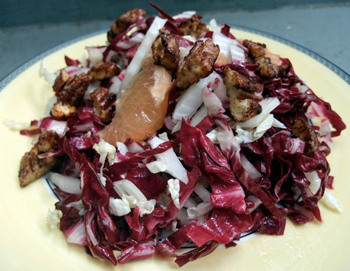 I do enjoy winter. Aside from the holidays, which can be as stressful and maddening as they are glorious, there is a natural exaggeration of the contrast between “outside” and “inside,” between the biting cold and isolation of a Michigan winter and the warmth and community to be found at home. There are very few experiences I prefer to that of coming into a warm house after spending time outside shovelling, sledding or taking a walk with the dogs; my body naturally melts into the ambient warmth, and (with a little luck) there can be hot chocolate or a cup of tea in my immediate future.
I do enjoy winter. Aside from the holidays, which can be as stressful and maddening as they are glorious, there is a natural exaggeration of the contrast between “outside” and “inside,” between the biting cold and isolation of a Michigan winter and the warmth and community to be found at home. There are very few experiences I prefer to that of coming into a warm house after spending time outside shovelling, sledding or taking a walk with the dogs; my body naturally melts into the ambient warmth, and (with a little luck) there can be hot chocolate or a cup of tea in my immediate future.
Its good to come in from the cold, but I can ratchet my pleasure level even higher if there is something delicious in the oven, scenting the house and promising good things to come. Winter is not about the quick, refreshing fruits and vegetable of spring and summer which often require just a knife and maybe a little kosher salt. Winter is a time for the slow, deep flavors that come from long cooking of root vegetables and cuts of meat too tough and complicated to be thrown on the grill. It is a perfect time for braising and stewing, which let you begin with tough (but flavorful) protein and thick, starchy vegetables and end with tender meat and vegetables as well as sauce or gravy infused with the flavors and scents of meat, vegetables, and the aromatics of your choosing.

 As part of my resolution to eat more salad, I am trying to buy ingredients that can be turned into a salad without too much fuss. You practically need to buy tender salad greens every day so I've been buying crunchy vegetables and hardier leafy greens instead. On my shopping lists these days are daikon radish, carrots, celery, fennel and red radishes. Shaved thin, they all are great salad fixings. I also buy avocados, and some citrus fruit to gussy up my salads.
As part of my resolution to eat more salad, I am trying to buy ingredients that can be turned into a salad without too much fuss. You practically need to buy tender salad greens every day so I've been buying crunchy vegetables and hardier leafy greens instead. On my shopping lists these days are daikon radish, carrots, celery, fennel and red radishes. Shaved thin, they all are great salad fixings. I also buy avocados, and some citrus fruit to gussy up my salads.  I know many of you love winter so I shall do my best not to disparage it. However, it’s not my most favorite time of year as I’m a creature of warm weather and open-toed shoes. But if there’s one bright shining spot to the season it’s most definitely citrus. Citrus in any form. When I begin to see the beautiful stacks of pommelos and meyers I can’t help but get excited and my mouth begins to experience sympathy pucker just looking at them.
I know many of you love winter so I shall do my best not to disparage it. However, it’s not my most favorite time of year as I’m a creature of warm weather and open-toed shoes. But if there’s one bright shining spot to the season it’s most definitely citrus. Citrus in any form. When I begin to see the beautiful stacks of pommelos and meyers I can’t help but get excited and my mouth begins to experience sympathy pucker just looking at them. With cookies and cocktails flying everywhere the last month, I almost forgot to share this recipe for Honey Roasted Sweet Potatoes with Pomegranate Glaze. That would have been a shame because this dish, which I created a couple of months ago, has skyrocketed to the top of my go-to recipe list.
With cookies and cocktails flying everywhere the last month, I almost forgot to share this recipe for Honey Roasted Sweet Potatoes with Pomegranate Glaze. That would have been a shame because this dish, which I created a couple of months ago, has skyrocketed to the top of my go-to recipe list. It happens every week. As I'm selecting my Swiss chard, kale, or collards, someone inevitably sidles up to me and asks, "What do you do with that?" Then after I share a recipe idea, she usually follows up with, "To me, they're all the same."
It happens every week. As I'm selecting my Swiss chard, kale, or collards, someone inevitably sidles up to me and asks, "What do you do with that?" Then after I share a recipe idea, she usually follows up with, "To me, they're all the same."
